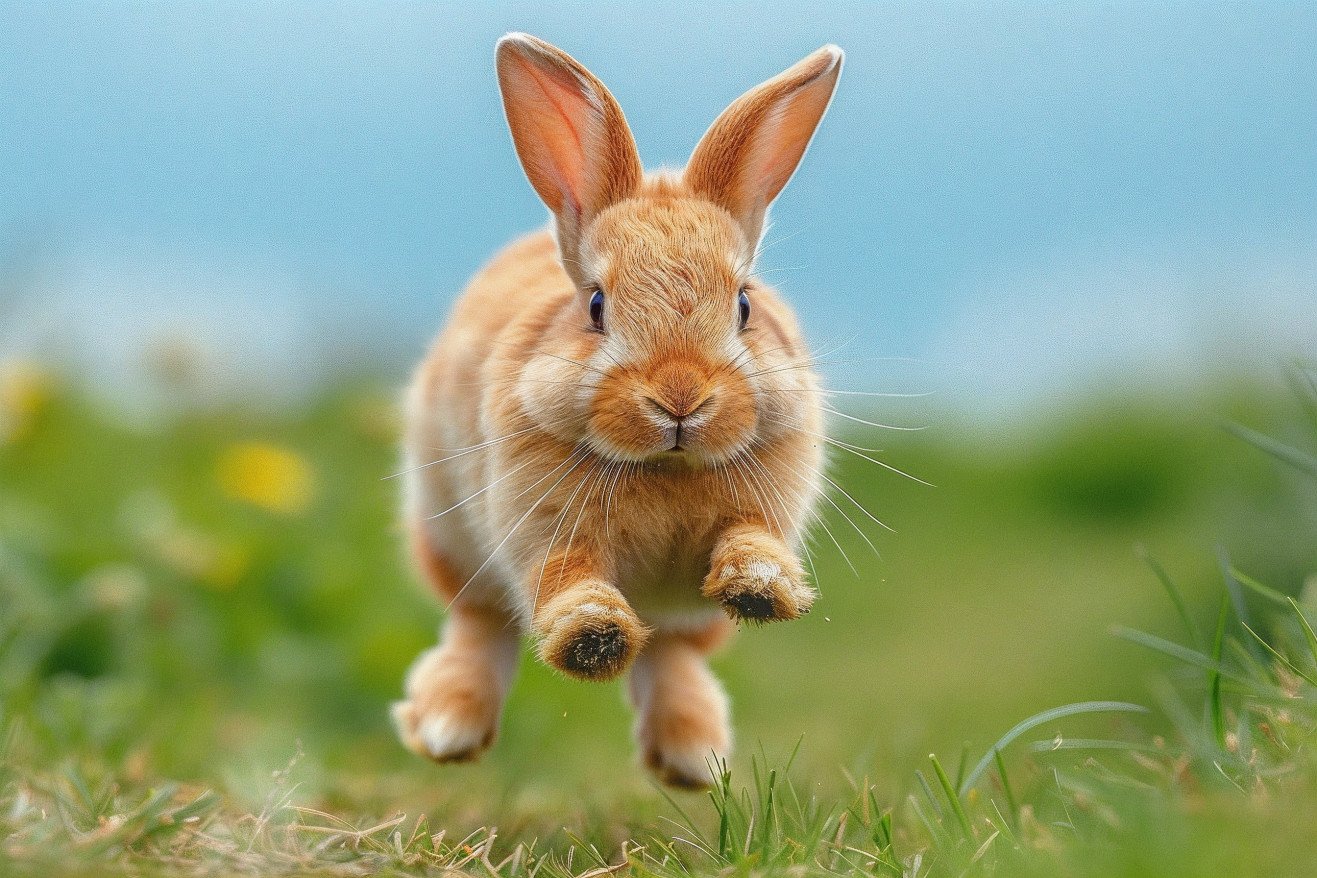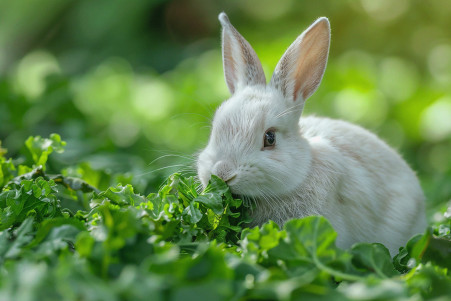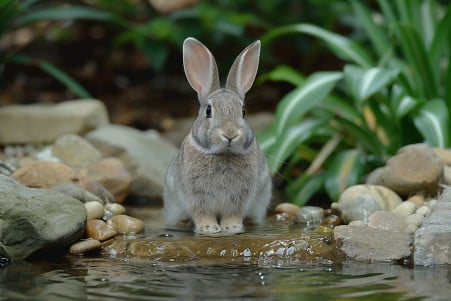How High Can Rabbits Jump? Unveiling Their Leaping Limits
15 February 2024 • Updated 15 February 2024

Rabbits are known for their incredible athleticism, but what are the limits to their jumping abilities? On average, healthy adult rabbits can jump up to 2 feet, but there are some breeds that can jump even higher. The current world record for rabbit jumping is 42 inches, which was achieved in rabbit high-jumping competitions.
This investigation into rabbit jumping spans a range of scientific fields, from veterinary medicine to animal behavior to physiology. It draws on everything from scholarly journals to practical animal care manuals. By the end, you will have a well-rounded view of the factors that contribute to rabbits’ ability to jump, from their anatomy to their breed to their training.
How high can rabbits jump?
How Do Rabbits Jump? The Science Behind Their Leaping Abilities
Rabbits have a unique musculoskeletal system that is responsible for their ability to jump. The muscles in their hind legs are especially important in enabling them to jump. A study in PubMed explains that the architecture of rabbit hindlimb muscles is adapted to their functions.
The quadriceps, with large pinnation angles and low fiber length/mass ratios, are indicative of a force-producing design that is necessary for powerful jumps. On the other hand, the hamstrings are designed to allow a lot of movement, which is important for the rabbit’s agility.
When rabbits jump, they use a biomechanical process to convert kinetic energy. The plantarflexors, as well as other muscles and tendons, are designed to produce force, while the dorsiflexors are designed to enable the movement of the limbs. The muscles and tendons work together to enable rabbits to jump to great heights, with some rabbits even breaking world records by jumping as high as 107 cm (42.1 inches), according to Wikipedia.
As a result, the anatomical adaptations are directly related to the physiological constraints. Not only does an understanding of the biomechanics of each jump help explain the potential of rabbits, but it also helps explain why there is so much variation between different breeds.
The Genetics of Rabbit Jumping
Rabbit jumping ability is highly dependent on genetics, and the breed of the rabbit is a major factor in determining how high a rabbit can jump. According to A-Z Animals, the average rabbit can jump up to two feet, but there are some breeds that are known for their exceptional jumping ability.
For example, the Belgian Hare, which is also known for its high energy and ability to learn tricks, is also known for its jumping ability.
Genetics also play a big role in how high a rabbit can jump, with the Netherland Dwarf being able to jump up to 39 inches.
In general, however, medium-sized rabbits are the best jumpers, as their size and strength are in perfect proportion to allow them to jump the highest. This may be why the official world record for the highest rabbit jump is 39.2 inches, which was set by the medium-sized, strong rabbit Mimrelunds Tösen, according to New Rabbit Owner.
Breeders have worked to improve these abilities by selectively breeding rabbits to combine the best of different breeds and push the limits of rabbit jumping ability. The result is a competition that showcases the best of rabbit jumping, where breed and genetics come together to set new records. This range of abilities shows that understanding the genetics of rabbits is key to helping them reach their full potential in agility and other competitive events.
Rabbit Hopping: The Science of Training for Bigger Jumps
While the training of rabbits for agility and bigger jumps is a science, it’s also an art. The training process for Rabbit Hopping often starts with bonding and basic command training. This important base begins with basic jumps that are typically 8–12 inches high, and the difficulty level is increased as the rabbit becomes more skilled.
Similarly, the Ontario SPCA and Humane Society’s trainers use cues and positive reinforcement with treats to encourage the rabbits to jump over the obstacles.
One of the most important factors is the age at which training starts. While rabbits can be trained at any age, it’s best to start training when they’re around four months old so that they’re still learning to jump.
An early start, along with conditioning and socialization, can have a big impact on how high rabbits can jump. Trainers are essential in helping rabbits reach their full potential by guiding and safely training them to jump higher while always keeping their well-being in mind, as Bunny Lady points out.
The welfare implications of training are essential; the rabbits’ well-being must always come first. As trainers continue to explore the limits of rabbit hopping, they’re doing so in a way that’s responsible in helping the rabbits reach their full potential as athletes by prioritizing these welfare principles.
Navigating the Highs and Lows: Keeping Rabbit Hopping Safe
Although rabbits are natural jumpers, their love of the sport can come with some dangers. Rabbits can sustain injuries like broken bones, arthritis, or spinal issues from jumping, especially if they don’t land properly or jump from too high a height.
PDSA notes that if a rabbit is limping, it could be a sign of a more serious issue and urges rabbit owners to take their pets to the vet if they show any signs of pain or reluctance to move.
As nidirect explains, one way to prevent these issues is to make sure that rabbits have a safe space to jump and play.
It’s also important to take physical limitations into consideration. If a rabbit is pushed to jump when it doesn’t want to, it can lead to strain and injury. Protect My Paws stresses that rabbits should never be forced to jump as this can lead to both short-term and long-term injuries. Instead, rabbit owners and trainers should set up environments that allow rabbits to make choices about their movements.
It’s also important for rabbit owners and trainers to be aware of the potential health risks of rabbit jumping. By making sure that the environment is safe and supportive, you can make sure that your rabbit’s agility is a fun and positive thing.
By being mindful of safety and physical limitations, you can help ensure that rabbits stay healthy and maintain their love of jumping, which can help keep them healthy and happy.
Fueling the Leap: The Vital Role of Nutrition in Rabbit Jumping Performance
To jump to such great heights, rabbits need to eat a diet that provides them with the energy and nutrients they need to build and maintain muscle.
Oklahoma State University notes that a high-fiber diet, primarily from grass hay, is important to maintain a healthy digestive system. While this doesn’t directly impact their jumping abilities, it does impact their overall health and, therefore, their ability to jump.
According to a study in ScienceDirect, a rabbit’s diet, including the protein they get from grass, is important to muscle development, which in turn impacts their ability to jump. This is because proteins are important for muscle mass and tissue repair.
To improve a rabbit’s jumping abilities, Oklahoma State University suggests a diet that includes a combination of unlimited hay, a variety of greens, and a small amount of fresh fruit.
However, a study in ScienceDirect notes that protein quality and quantity must be monitored, as pets need less protein than their commercial counterparts to avoid obesity and maintain gut health.
Meanwhile, a 2023 study by Dr. Islam M. Saadeldin, published in PMC, found that adding whey powder as a protein source to a rabbit’s diet can increase muscle content and improve gut health, which could improve their physical abilities, including their jumping skills.
Good nutrition is important for both pet rabbits and those used in competition. A rabbit’s diet impacts their athletic performance, ensuring they can jump as high as possible while maintaining their health.
Reaching New Heights: What Makes Rabbit Jumping Possible
When we think about the physical traits that make rabbit jumping possible, we can see that there are several things that make it possible for rabbits to jump so well. While the average house rabbit can jump between 2 and 3 feet, the current world record holder, Holloway Ch Tennessine, has jumped an incredible 42 inches.
The rabbit’s powerful hind legs, strong muscles, and efficient biomechanics are all important parts of the rabbit’s physical makeup that make these jumps possible.
The rabbit’s physiology, the genetics of its breed, and the training it receives all play a role in how high a rabbit can jump. Pet Keen notes that the differences between rabbit breeds mean that they have different leg lengths and muscle masses, which can affect how high they can jump. Meanwhile, a study by Rabbit Care Tips found that trainers can help rabbits reach their full potential and even exceed it.
Responsible rabbit care and training are important for helping rabbits achieve their best jumps. In order to make sure that we can continue to enjoy and help rabbits reach their full potential, we need to make sure that we’re taking care of them in the best way possible.
This means that we need to make sure that we’re prioritizing their health and well-being, even as we continue to be fascinated by their jumping abilities. As rabbits jump through the air, we can see that their jumps are the result of a complex combination of nature and nurture.


